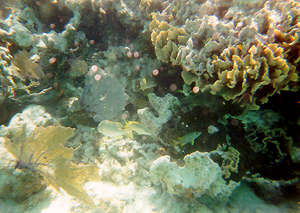|
| 
Coral Reproduction- How do they do it?How is it possible for coral to reproduce? Considering how long it takes for coral to grow even in optimum conditions (approximately .8 inches/year), it is important for coral to increase it's rate of survival by using two types of reproduction: sexual (with a partner) and asexual (by themselves). Sexual reproduction, or spawning. occurs when all the coral in a particular geographic region, release their eggs and sperm into the water. Once the sperm fertilize the egg, a new individual is formed called a planula. Floating up toward the light, the planula drifts with plankton up to several weeks. The surviving planula finally rests upon a firm foundation, such as rocks or the occasional shipwreck. and develops into polyps that eventually compose a reef. Different reefs around the world experience spawning at specific times. For Belize, the spawning usually takes place in August, although this past year there was evidence that spawning also occurred in September, an anomaly of sorts. Scientists and researchers often gear up to witness this supposed once a year event that is presumed to correlate with the cycles of the moon; spawning always occurs a night or two after the full moon. It is the goal of many, researchers in Belize to eventually capture this spectacular event on film.  Although sexual reproduction is the most common and arguably the most important type of reproduction, some polyps experience asexual reproduction by cloning themselves. The constant addition of new polyps forms a colony that stabilizes itself to the limestone skeletons of old polyps, thus creating the foundation of the reef. This type of reproduction is important because when damage is sustained due to storm surges or hurricanes, coral has the incredible ability to grow from broken-off pieces of the original colony.
Although sexual reproduction is the most common and arguably the most important type of reproduction, some polyps experience asexual reproduction by cloning themselves. The constant addition of new polyps forms a colony that stabilizes itself to the limestone skeletons of old polyps, thus creating the foundation of the reef. This type of reproduction is important because when damage is sustained due to storm surges or hurricanes, coral has the incredible ability to grow from broken-off pieces of the original colony.
When we visit the reef to snorkel, dive. or swim, it's easy to overlook the remarkable amount of time that goes into the formation of the reef. This slow-going process should be reason enough to protect the reef because when it's gone there, won't be a replacement for a very long time. Remember to limit your impact to the reef by never touching, stepping on. or taking the coral and always anchor your boat to a buoy. In this way, we can all enjoy the reef for generations to come. This Reef Brief was written by Ann Hayden, check out our next Reef Brief to learn more about the fish who make the reef their home.
|
 Copyright by Casado Internet Group, Belize |